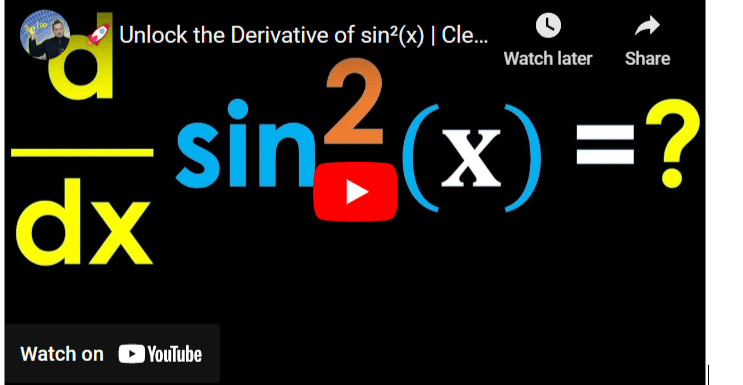| Step | Expression | Explanation |
|---|---|---|
| 1 | d/dx sin²(x) | Start with the original function |
| 2 | d/dx [sin(x)]² | Rewrite sin²(x) as [sin(x)]² |
| 3 | 2 sin(x) d/dx sin(x) | Apply the chain rule |
| 4 | cos(x) | Differentiate sin(x) to get cos(x) |
| 5 | 2 sin(x) cos(x) | Substitute into the chain rule formula to get the derivative |
Graph of \( f(x) = \sin^2(x) \) and its Derivative \( f'(x) = \sin(2x) \)
Below is the graph of the function \( f(x) = \sin^2(x) \) and its derivative \( f'(x) = \sin(2x) \).
Relationships Between the Graphs
The relationships between the graphs of \( f(x) = \sin^2(x) \) and its derivative \( f'(x) = \sin(2x) \) are described as follows:
- The graph of \( f(x) \) is a periodic function with a wave-like shape, oscillating between 0 and 1.
- The graph of the derivative is also periodic but oscillates between -1 and 1, with a period half that of the original function.
- The zeros of \( f'(x) \) correspond to horizontal tangents in the graph of \( f(x) \).
- Where \( f'(x) > 0 \), the original function is increasing, and where \( f'(x) < 0 \), it is decreasing.
- The amplitude of both functions is 1, but the derivative has more frequent oscillations.
- The derivative is obtained through the chain rule, reflecting the combined effect of the square and sine functions.
- Both functions exhibit symmetry, with \( f(x) \) symmetric about the y-axis, and \( f'(x) \) symmetric about the origin.
In summary, the graphs are related through calculus principles, reflecting the original function’s local behavior. The derivative graph provides insights into the original function’s rate of change, turning points, and overall behavior.

